#genuine fossil ammonite
Explore tagged Tumblr posts
Photo

9.5" Bradfordia inclusa Fossil Ammonite – Inferior Oolite, Jurassic Coast: Burton Bradstock, Dorset, UK
Presenting a stunning 9.5" fossil ammonite of the species Bradfordia inclusa, found in the classic Inferior Oolite formation of the Jurassic Coast, specifically at Burton Bradstock, Dorset, UK. This ammonite is a well-preserved and large specimen, showcasing impressive morphological features from the Middle Jurassic.
Species: Bradfordia inclusa
Geological Unit: Inferior Oolite Formation
Geological Period: Middle Jurassic
Stage: Bajocian
Zone/Biozone: Parkinsoni Zone (inferred from stratigraphy)
Depositional Environment: Shallow marine carbonate shelf
Order: Ammonitida
Family: Otoitidae
This ammonite is characterised by its robust, involute shell with strong, radiating ribs and moderate ornamentation—a classic representative of the Middle Jurassic cephalopod fauna. Bradfordia inclusa is a rare and desirable genus for collectors due to its limited stratigraphic range and size.
This exact specimen was discovered by our dedicated fossil team members Alister and Alison on 17 January 2025 and later meticulously cleaned, prepared, and preserved by Alison to highlight its features and protect it for long-term enjoyment.
Notable Features: Rare, large-sized specimen; exceptional preservation of suture lines and ribbing
Scale Reference: Scale cube shown is 1cm – refer to images for full size clarity
All of our Fossils are 100% Genuine Specimens & come with a Certificate of Authenticity.
Ideal for any collector of Jurassic marine fossils, museum-quality displays, or enthusiasts seeking a dramatic centrepiece from the UK's iconic fossil coast.
#Bradfordia inclusa#fossil ammonite#Jurassic ammonite#Inferior Oolite#Burton Bradstock fossil#Dorset fossil#Jurassic Coast fossil#large ammonite#Middle Jurassic fossil#genuine fossil ammonite#ammonite specimen UK#ammonite with authenticity
0 notes
Text

Anyone who enjoys geology, history, and paleontology will love these cards for playing your favorite games or to use as flash cards. Inspired by Adventure Publications’ guides to rocks, minerals, and fossils, this gorgeous deck of playing cards by geologist, paleontology expert, and debut author James St. John features professional photographs of 54 of the most representative fossils found in the United States and Canada. Suits are organized chronologically, and each card depicts a full-color photograph, including everything from billion-year-old stromatolites and dinosaurs like the famed Tyrannosaurus rex to more recent finds that are bound to surprise. So you can begin to learn what 54 different variations of fossils look like.
#geology#paleontology#games#card games#card game art#collectibles#rocks and minerals#game#board games#prehistoric#learning#fun#enjoy#friends#students of tumblr#sea fossil#fossil#marine fossil#fossils#ammonite#genuine fossil#dinosaurs#paleoart#dinosaur#paleoanthropology
11 notes
·
View notes
Text
What are Some Good Uses for Giant Claw Fossils?

At Fossil Age Minerals, we proudly offer a selection of genuine raptor fossil for sale, including impressive raptor claw specimens. Our collection showcases the fascinating details of these ancient predators, providing a unique glimpse into their prehistoric world. Whether you’re a collector, educator, or enthusiast, our raptor fossils are meticulously preserved and ready to enhance your collection or exhibit. Explore our range today and contact us for more information on pricing and availability. Read more: https://qr.ae/p2KTiP
0 notes
Text
author notes for chapters 6 & 7 of The Witch and the Widow
For the sake of getting this going with some images, lets start off with the fossil! (Pentacrinites crinoid/sea lily). Ok so I know I wanted something that would remind Imogen of her scars and get her a little spooked. I was researching fossils likely found on the coast because that just feels genuine to another hobby Laudna would have (how practical is its application? stay tuned!), and this one came up and I was like, ah, that works. (I enjoyed the film ‘ammonite’ personally, okay.)



These little weird guys worked so well, especially along with the theming of the other species discussed, and when I saw the current day relatives of them and how alien they are I was like yeap. Perfect fit.
youtube
Can’t remember if I said in a previous notes that I intend to draw a little diagram of how I see Imogen’s scars being in this au, but I think the fossil photos do a pretty good job of getting it across. I see the structure as still being lightning/root like, but a lot more dense, her skin a lot more gnarled from it, so there isn’t really any skin in between the scarring, it’s just slowly encasing her from the fingertips up.
'The waves break and their sound could be wind through tree canopies. She is no longer outside to know otherwise, no longer in the presence of the Lady, and Sorcha is asleep.
She removes her gloves, places them on the table-top beside the fossil, taking it into her hands.
Something she can do.
What she can do, she thinks, as her bare fingertip traces along the spine of the long-passed sea lily suspended in rock and time, is how if she wished she could, she could hold this fossil in front of herself without use of her hands, could rotate it and look at it from every angle without their obstruction.
But under her touch the ridges are skeletal, delicate vertebrae surfaced from an arched back, silver marble pale in the moonlight glow, embossed, statuesque, tooled with as much intent as a blade hammered into leather
Similar in how those flowers that decorate the Lady’s saddle are not quite floral, because they are rendered in what was once flesh. Same as for the sea lily that is not a flower but is named as such, whose body turned to stone.
Imogen was wrong to think of its patterns as kin to her scars, even if the swell of them satisfyingly slots into the gouges of her contorted tissue.
No. She will die and her body will most likely become compost; no different to the hay she forks into large heaps, or her mother and her pinewood headstone left exposed to the elements.
She doesn’t really understand how something soft and organic can become stone, but she does understand care and attention, can see a saddle passed down through centuries and generations and time would be the stone that encases it, what makes it indelible, floral patterns in flesh that doesn’t decompose.
And to feel it is to marvel.
And she does.'
Having more fun with vegetarianism and the flesh and sacrifice and being a predator or prey - thanks to the recent episodes for that being particularly satisfying and validated - it’s a theme of this story that I personally find very enjoyable, and I think it plays in a fun way with the canon, Imogen as a vessel, her powers derived from a god-eater, Imogen abstaining from flesh but innately drawn to these women who butcher that are arguably above her in the foodchain, the powers she has over them but is too scared to utilise against or around Laudna, and recently newer powers that she cannot display in a world seemingly without magic. She had her first bit of seafood. Is it flesh? Depends who you ask.
What title or name Imogen refers to Laudna in her head as… she’s acclimatising to calling her by her first name as she had been asked, but she can’t quite shake the formalities of class and hierarchy. we got some mistresses, her Lady’s, and even a few Laudna’s without the Ms during that saddle scene. What a breakthrough, huh? If you want more of my process on these sorta writing choices feel free to message me I guess, same if you wanna see photos of locations that inspired me. I’m not confident if anyones gonna read this so idk how much of my own time I should waste on exposing my wanky chat.
So! These two chapters are my lust-letter to the british seaside. A lot of the environmental descriptions are inspired by memories and photographs I’ve taken over my years on visits to old seaside towns and villages, or hikes along the coast line. Pansies growing between cobblestones in a back alley leading to the seafront, crab shells dotted about the place that must have been dropped from birds out of the sky, smokehouses and their chimneys, nights spent looking out of an old cottage skylight at all of the roofs covered in sea mist and only being able to hear the waves despite being right by the water, old piers that act like walkways into the sea so you can almost pretend you’re standing in the middle of it. my dad’s side of the family is heavily intertwined with maritime history, he never really saw much of his old man and the same of his grandfather caus they was always away all around the world on huge ships for months and years at a time, and most of his other family members were fisherman and lifeboatmen in a couple of small coastal towns. I don’t know if having those stories to boot made my feelings on the environment any different than they would have been or if it’s something innate, but I’ve always felt this sort of astounding fear and wonder and respect when I’m by the water on the coast, it’s a place that by its nature makes you feel really humbled and reflective, and I guess it felt fitting for a lot of the feelings Imogen has towards Laudna as of the moment (and maybe you've picked up that water is a bit of a focus in this story too)
Similarly I’ve seen a lot of castles and castle ruins in my time, and many of these are still balancing on cliffs along the coast. It felt a good opportunity for Imogen to encounter a place from one of her dreams, seeing as she’s not really leaving the estate grounds too often, so I took that narrative opportunity to have that dream be made a reality to her, but bring in the questions of why did the lady tell her to go there, is it by chance or does she know yet another thing that Imogen doesn’t? is this a place she can try to tie a name to now she knows its heraldry? When will Imogen get into the starpoint conservatory!!! (lol, Laudna's library)
as always, a bit silly of me sharing authors notes on a story thats very much got a lot of mystery going on, but i hope at least the visual notes on the scars add to some enrichment, idk. thanks for reading either way. looking forward to red stringing this all down the line and making a powerpoint presentation loljk (i would)
19 notes
·
View notes
Text
My genuine domestic cat skull arrived yesterday!!!

I have been after a domestic cat skull for ages. But they were always either bobcat skulls, replicas, vet teaching specimens (very dear) or in USA (but not shippable).
I did find one in the UK though and they have the small premolar behind the canine. Which domestic cats have but bobcats don't.
Original owner said they were from a feral cat colony. They were sold on to pay for her cats diabetic vet bills.
Just removing the hot glue from jaw today.

In the display cabinet with some fossils, rabbits skulls, claws and teeth.
Also an old dragon ornament, hag stone, sea glass, bunny ornaments, blown glass lizard, dolphin and seahorse. A mini bunny puzzle, Anubis on "gold" plinth and Tim Burton easter bunny figure.
Gemstones are blue topaz, raw sapphire, mangonite, a meteorite, raw yellow topaz and amber with insect inclusion.

Some of my fossils close up. They are Cave bear metapodial, two Spinosaur teeth, mosasaur tooth, and mosasaur teeth in jaw peice. There is also a plastic replica of a velociraptor claw (the other fossils are genuine though). I also have two ammonites out of shot (one with nacre).
I also have a guinea pig skull and a diaphonised fetal rabbit head on another shelf.
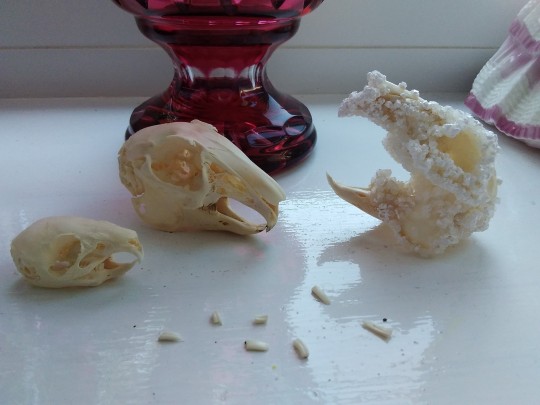
Here are three of my skulls. Guinea pig on left, then two rabbits. Also bunny teeth. Older photo on windowsill, so no cat skull at the time.
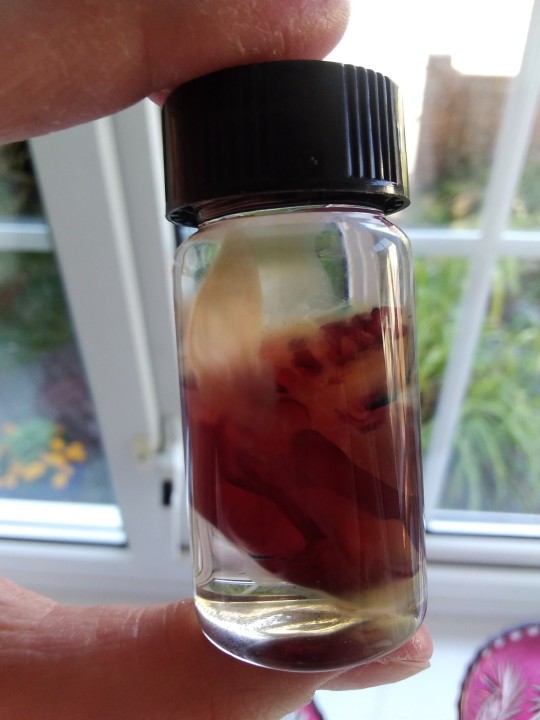
Diaphonised fetal rabbit head
#cat skull#tw: bones#fossils#rabbit skull#vulture culture#my stuff#my bone collection#guinea pig skull#bone collecting
25 notes
·
View notes
Text
Smelly Shelly. I love dinosaur Shelly but I like cephalopod Shelly more. I tried to understand ammonite anatomy but I was genuinely tweaking at the vocabulary. If only I had a prehistoric nerd to educate me on this stuff.
Anyways Shelly. probably used to sew with Glisten (in my au). Loves creating flowy dresses. She does have excavation gear though for fossil hunting, but she never got the chance to use it. Also her ass does not need glasses.... She just thinks they're fun to wear.
Did not feel like rendering her at the moment. Maybe later. UGHHHHHAUAAHUAAHAH... Pretty shell :]



#dandys world#dandy's world au#dandy's world shelly#dw shelly#shelly fossilian#dandy's world fanart#probably looks at pretty women and goes “do i like her or do i want to BE her”#picks the latter option and is surpised when shes unhappy
5 notes
·
View notes
Text

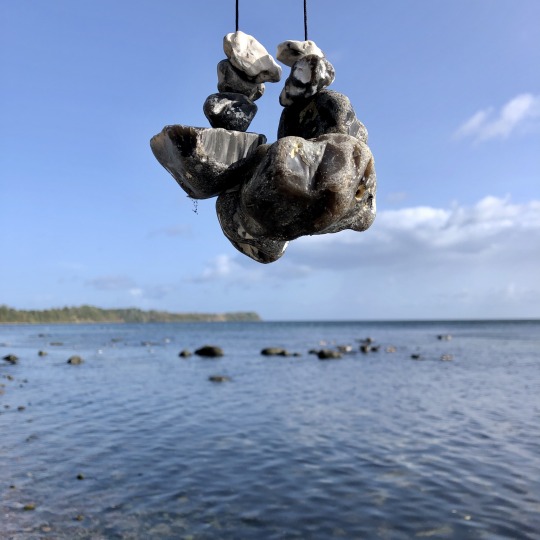
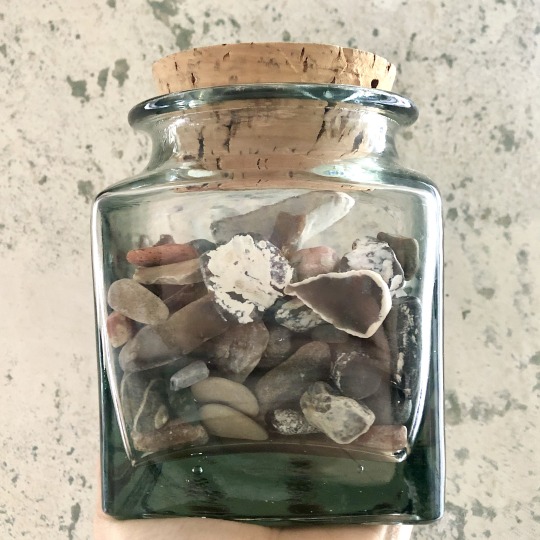
I was thinking about clothes today and two movies popped into my head. "The Banshees of Inisherin" and "Ammonite" with Kate Winslet. Her clothes are fantastic in this movie. The knitted sweaters in "The Banshees of Inisherin" are also fantastic. But "Ammonite" reminded me of something last summer. I found 12 Hühnergötter at once on the beach and picked up all the stones I found beautiful. I put them in a pile in front of my tent to see which ones I would keep later. At some point, the guy camping next to me approached me and asked about the stones I had collected. And I said. Oh that's nothing, I have no idea and just put in what I like. But he sounded like he had a clue and was genuinely interested. So we looked through the stones together and found a piece of a fossilized sea urchin and a piece of an octopus. It turned out he was from the town I moved away from 9 years ago and is a biologist. He was there to watch birds. He had an incredibly large pair of binoculars with him, with which I could see the craters on the moon. It was a wonderful encounter. Later, a storm came up and I woke up in the morning in a 10 cm deep puddle. But my tent held tight :)
About the knitwear in "The Banshees of Inisherin"
Makes me miss Ireland even more than I already do.
#ammonite#fossil#sea urchin#octopus#its always the sea#ireland#knitwear#irish sweater#the banshees of inisherin#knitting
14 notes
·
View notes
Text
tag game: pick stuff from your room and have people vote on which one they want to take home.
6 notes
·
View notes
Note
"Hello, I come bearing gifts from my coven. A couple of our witches wanted you to have these," Mai presents a jewelry box with ammonite fossil, clear quartz, carnelian, amethyst, garnet, and black onyx; all of them are genuine and well polished. "I hope they are to your liking, your majesty. They put quite a lot of thought into it."
His eyes widen like a cat who’s seen something they like, ooh it’s all Shiny ! So shiny !! They are going right to his horde ! “Oh thank you!! I love them! What gifts or blessings does your coven need?” He asked as he happily took the box.
3 notes
·
View notes
Text

These genuine ammonite fossils from Madagascar have inlaid abalone shell set into the fossil's chambers. Unique earrings!
2 notes
·
View notes
Photo
i feel like this has become an ur-aesthetic post. this sink gets posted by all kinds of aesthetic blogs on all platforms. r/designporn, random esoteric twitter accounts with numbers station handles, right-wingers promoting ideas of "natural beauty in harmony with modern life", edgy art blogs that post only monochrome. pinterest interior design ideas.
ive seen this sink from a half dozen angles in slightly different lighting and aspect ratios and resolutions for almost 20 years. it's less an old friend than the guy you see at your nearest gas station once every 6-36 months, and every time he just buys a 40 and puts $20 on his pump, wearing the same hat and genuinely faded jeans. he's maybe not exactly where he wants to be, but hes in equilibrium, doing what is simplest.
this sink simply prompts a "oh, that's neat" with mechanical consistency, and gets reposted over and over and over again. nothing more. it's designer probably labored over the ridges and angles, giving the spiral curve the right widths and depths, using ammonite fossil reference. but that rarely gets considered, and it's honestly not a deep well of analysis. it is, actually, just neat, with enough depth to occupy the mind just as long as the water it carries: maybe 3 seconds. and that's enough to make it perfect to get a like, and maybe a share.
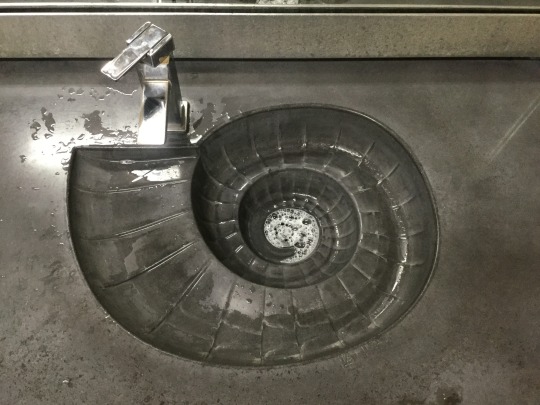
Fossil sink
27K notes
·
View notes
Photo

Euhoplites lautus Fossil Ammonite Cretaceous Folkestone UK | Gault Clay Middle Albian Genuine Specimen with Certificate
This listing features a genuine Euhoplites lautus ammonite fossil, collected from the famous Gault Clay Formation exposed at Folkestone, Kent, United Kingdom. Dating to the Middle Albian Stage of the Cretaceous Period (approximately 105 million years ago), this ammonite represents a key faunal element of the rich marine ecosystems that once covered southern Britain.
The exact fossil pictured is the one you will receive. It has been carefully selected for its preservation, diagnostic features, and provenance. All our fossils are 100% genuine and are supplied with a Certificate of Authenticity.
Geological & Palaeontological Details:
Species: Euhoplites lautus
Fossil Type: Ammonite
Family: Hoplitidae
Superfamily: Hoplitoidea
Order: Ammonitida
Geological Period: Cretaceous
Stage: Middle Albian (approx. 107–104 million years ago)
Formation: Gault Clay
Location: Folkestone, Kent, UK
Biozone: Found within the Euhoplites lautus Zone, a key ammonite biozone in the Gault Clay biostratigraphy of southeast England
Depositional Environment: The Gault Clay was laid down in a low-energy, offshore marine environment with fine muds and clays that provided excellent conditions for fossil preservation. This marine shelf supported a diverse array of cephalopods and other invertebrates.
Morphology & Features:
Euhoplites lautus is known for its tight coiling, robust falcoid ribs, and strong ventrolateral tubercles
The whorls are typically compressed with sharply defined ornamentation and occasionally a keel
These features make it an easily recognisable and biostratigraphically important ammonite
The fossil may exhibit finely preserved suture lines and surface ornamentation typical of Gault Clay specimens
Notability: First formally described by Spath in 1923, Euhoplites lautus is the index fossil for its zone, and plays a vital role in Albian biostratigraphic zonation. It is a prized specimen among collectors and researchers for its diagnostic clarity and excellent preservation potential in the Gault Clay.
Additional Details:
All our fossils are 100% genuine specimens
Comes with a Certificate of Authenticity
The photo shows the exact fossil for sale
Scale cube = 1cm – see listing images for full size reference
This rare and well-preserved ammonite provides a fascinating glimpse into the marine world of the Albian Cretaceous seas. A valuable specimen for collectors, educators, and enthusiasts of Earth’s deep history.
#Euhoplites#lautus#fossil ammonite#Gault Clay fossil#Middle Albian#Cretaceous ammonite#Folkestone fossil#Kent fossil#UK ammonite#British fossil#ammonite with certificate#genuine fossil ammonite#collector ammonite#ammonite display piece#marine fossil#Hoplitidae#ammonite from Gault Clay#Cretaceous sea life#Albian ammonite
0 notes
Photo

PHYLLOCERAS Fossil Ammonite, Aptian Stage, Cretaceous Period | Genuine Moroccan Specimen + COA
PHYLLOCERAS Fossil Ammonite – Aptian Stage, Cretaceous Period, Morocco
This beautifully preserved Phylloceras fossil ammonite represents an extinct genus of cephalopods that thrived during the Aptian stage of the Early Cretaceous, around 125 to 113 million years ago. Found in the fossil-rich strata of Morocco, this specimen offers a fascinating glimpse into ancient marine ecosystems and the evolution of ammonoids.
Fossil Type & Species:
Type: Invertebrate Fossil (Ammonite Shell)
Genus: Phylloceras
Order: Ammonitida
Suborder: Phylloceratina
Family: Phylloceratidae
Geological Age: Aptian Stage, Early Cretaceous (approx. 125–113 million years ago)
Geological & Stratigraphic Details:
Formation: Likely from Cretaceous marine deposits of the Atlas Basin or adjacent units in Morocco
Depositional Environment: Open marine setting with fine sedimentation that supported the fossilisation of delicate cephalopod shells
Biozone: Aptian ammonite-bearing marine strata (specific zonation not formally assigned)
Morphology & Features: This Phylloceras specimen exhibits the key traits of the genus:
Strongly involute, smooth shell with subtle, fine growth lines
Globular to slightly compressed whorls with continuous outer curvature
No ribs or nodes, unlike many Jurassic or Cretaceous ammonites
Intricate suture lines visible on polished or naturally weathered sections
Fossilised in iron-rich limestone or marl, typical of Moroccan preservation, displaying earthy hues of beige, grey, or brown
Notable: Phylloceras is considered one of the most primitive and long-lived ammonite genera, known from the Triassic through the Cretaceous. Its smooth shell and complex sutures are diagnostic and make it both scientifically significant and aesthetically desirable.
Specimen Details:
Origin: Morocco (likely Atlas Basin or nearby marine units)
Genus: Phylloceras
Fossil Type: Ammonite Shell (Invertebrate)
Geological Stage: Aptian, Early Cretaceous
Size Reference: Scale rule square = 1cm (please refer to photos for exact sizing)
Note: You will receive the exact fossil specimen shown in the photos
Authenticity & Quality: We hand-select every fossil based on authenticity, preservation, and visual appeal. This specimen comes with a Certificate of Authenticity and is guaranteed to be 100% genuine — with no reconstructions or artificial enhancements.
Why Choose This Fossil? This Phylloceras ammonite is ideal for:
Fossil collectors seeking rare Cretaceous ammonites
Educational or teaching collections
Natural history and marine evolution enthusiasts
Unique and natural decor or gift idea
Shipping & Packaging: Carefully packed using eco-conscious materials. We offer fast, secure shipping with tracking to ensure your fossil arrives safely.
Add a timeless marine relic to your collection with this elegant Phylloceras fossil ammonite from the Cretaceous seas of Morocco.
All of our Fossils are 100% Genuine Specimens & come with a Certificate of Authenticity.
#Phylloceras ammonite fossil#genuine fossil ammonite#Aptian ammonite Morocco#Cretaceous ammonite fossil#Moroccan ammonite#fossil with COA#real ammonite shell#collector ammonite#Phylloceratina fossil#fossilised cephalopod#ancient marine fossil#authentic ammonite fossil#decorative fossil specimen#Aptian Cretaceous fossil#Phylloceras shell
0 notes
Photo

HOLCOPHYLLOCERAS Fossil Ammonite, Oxfordian Stage, Jurassic Madagascar | Authentic Specimen + COA
HOLCOPHYLLOCERAS Fossil Ammonite – Oxfordian Stage, Late Jurassic, Madagascar
This beautifully preserved Holcophylloceras fossil ammonite originates from the Oxfordian stage of the Late Jurassic Period, approximately 163.5 to 157.3 million years ago. Discovered in the fossiliferous marine limestones of Madagascar, this specimen represents a visually striking and scientifically valuable extinct marine cephalopod.
Fossil Type & Species:
Type: Invertebrate Fossil (Ammonite Shell)
Genus: Holcophylloceras
Order: Ammonitida
Suborder: Phylloceratina
Superfamily: Phylloceratoidea
Family: Phylloceratidae
Geological Age: Oxfordian Stage, Late Jurassic
Described by: Neumayr (1875)
Geological & Stratigraphic Details:
Formation: Jurassic marine limestone deposits, Madagascar
Location: Likely Mahajanga Basin or equivalent Jurassic marine platform
Stage: Oxfordian (~163.5–157.3 million years ago)
Depositional Environment: Shallow marine carbonate platform with fine sediments, ideal for fossil preservation
Biozone: Oxfordian ammonite zones (exact zone not formally assigned)
Morphology & Features: This Holcophylloceras specimen is characterised by:
Strongly involute, compressed shell with minimal ribbing
Fine longitudinal ornamentation and intricate suture lines
Highly symmetrical and smooth shell profile with a narrow umbilicus
Coloration ranging from cream to caramel and deep brown depending on mineral content
Often polished to reveal chamber structure and suture complexity for display
Notable: Holcophylloceras is a member of the Phylloceratina lineage, known for its elegant, smooth shells and highly complex suture patterns. It represents one of the more advanced Jurassic ammonites and is valued by collectors and palaeontologists for both scientific and aesthetic purposes.
Specimen Details:
Origin: Madagascar
Genus: Holcophylloceras
Fossil Type: Ammonite Shell (Invertebrate)
Geological Stage: Oxfordian, Late Jurassic
Size Reference: Scale rule square = 1cm (see photos for accurate sizing)
Note: The exact fossil shown in the photographs is the specimen you will receive
Authenticity & Quality: This fossil is 100% genuine and has been carefully sourced for quality and preservation. It comes with a Certificate of Authenticity. No restoration or artificial enhancement.
Why Choose This Fossil? This Holcophylloceras ammonite is ideal for:
Serious fossil collectors
Museum or academic display
Education and teaching collections
Decorative and scientific interest
Shipping & Packaging: Secure and eco-conscious packaging with fast, tracked shipping ensures your fossil arrives safely.
Add a refined and rare marine fossil to your collection with this Holcophylloceras ammonite from the Oxfordian seas of Jurassic Madagascar.
All of our Fossils are 100% Genuine Specimens & come with a Certificate of Authenticity.
#Holcophylloceras ammonite fossil#Jurassic ammonite Madagascar#Oxfordian ammonite#genuine fossil ammonite#real ammonite shell#fossil with COA#collector ammonite specimen#Madagascan cephalopod fossil#authentic Jurassic fossil#ammonite for sale#polished ammonite shell#fossil ammonite Jurassic#rare ammonite fossil#Holcophylloceras fossil
0 notes
Photo

MICRACANTHOCERAS Fossil Ammonite Albian Cretaceous Madagascar Genuine Specimen
Available here is an authentic MICRACANTHOCERAS fossil ammonite from the Albian Stage of the Early Cretaceous Period (approximately 113 to 100 million years ago). This scientifically significant specimen was unearthed from fossil-rich marine strata in Madagascar, a premier location for Cretaceous ammonite fossils.
Geology & Origin:
Madagascar’s Albian marine formations were deposited in warm, shallow seas that fostered rich ecosystems. Ammonites like Micracanthoceras were abundant, and when they died, their shells were quickly buried under fine marine sediments. These conditions preserved the ammonites in fine detail, producing exceptional fossil specimens like this one.
Fossil Type & Species:
Type: Fossil Ammonite (Extinct marine cephalopod)
Species: Micracanthoceras sp.
Preservation: Excellent, with well-defined coiling and surface structure
Features:
100% genuine, natural fossil specimen
Includes a Certificate of Authenticity
Hand-selected for scientific and collector-grade quality
The exact specimen shown in the photographs
Scale cube = 1cm: Full sizing viewable in the image
Why Buy From Us? We specialize in offering professionally curated, genuine fossils that are carefully prepared and selected for their authenticity and visual appeal. Each specimen comes with a Certificate of Authenticity, ensuring trust and value.
Perfect for collectors, educators, or as a fascinating addition to your home or office natural history display.
#Micracanthoceras#Fossil Ammonite Madagascar#Albian Fossil#Cretaceous Fossil#Genuine Fossil Ammonite#Authentic Ammonite Fossil#Marine Fossil Madagascar#Natural Fossil Specimen#Fossil with Certificate#Ammonite Shell Fossil#Fossil Display Piece#Fossil Collector Item
0 notes
Photo

CLEONICERAS Iridescent Fossil Ammonite Lower Albian Cretaceous Madagascar Genuine Specimen
Offered here is a stunning CLEONICERAS iridescent fossil ammonite, preserved from the Lower Albian Stage of the Early Cretaceous Period (approximately 113 to 110 million years ago). This beautifully detailed specimen was discovered in the fossil-rich marine deposits of Madagascar.
Geology & Origin:
The Lower Albian epoch saw Madagascar submerged under shallow, tropical seas. Marine organisms such as ammonites flourished in this environment. Following their death, the shells of these creatures were quickly buried under fine marine sediments, preserving their forms. In rare cases such as this, the original aragonite shell layer fossilized with its mother-of-pearl iridescence intact—creating a dazzling display of natural color.
Fossil Type & Species:
Type: Fossil Ammonite (Extinct marine mollusc)
Genus: Cleoniceras
Preservation: Exceptional, with striking mother-of-pearl iridescence
Features:
100% genuine, natural fossil specimen
Includes a Certificate of Authenticity
Hand-selected for its preservation quality and aesthetic value
The exact fossil pictured is the one you will receive
Scale cube = 1cm: Refer to photos for full size and dimensions
Why Buy From Us? We provide only authentic, expertly prepared fossils sourced directly from reputable localities. Each fossil is carefully handled and comes with a Certificate of Authenticity, giving you complete confidence in your purchase.
A perfect collector’s item, an educational tool, or a breathtaking piece of prehistoric natural art for your home or office display.
#Cleoniceras#Iridescent Ammonite#Fossil Ammonite Madagascar#Lower Albian Fossil#Cretaceous Fossil#Mother of Pearl Ammonite#Genuine Fossil Ammonite#Natural Ammonite Fossil#Authentic Fossil Specimen#Fossil with Certificate#Ammonite Collector Fossil#Madagascar Marine Fossil#Fossil Display Piece
0 notes